
The field of plant protection is quite large. That’s why this article focuses on the measures one can take before a plant gets any kind of pest.
The best preventive plant protection is to keep the plant healthy and to stimulate its growth. Let’s have a look at the most important points.
1 Choice of site
Site and plant have to fit together. For example: Blueberries need acidic soils (most soils are only slightly acidic or neutral), mints prefer a quite humid soil and rosemary likes it dry. Not only the character of the soil but also the amount of sunlight, wind and the cardinal directions play an important role. Almost all crops need a lot of sunlight. Their preferred cardinal direction is south (southeast to southwest). Moreover, there are special cultivars of each plant. That means some cultivars of the same plant are more tolerant concerning shadow or humidity or aridity than other ones.
All in all, one can say that most crops need a lot of sunlight, a slightly acidic to neutral soil rich in humus and a good drainage.
2 Choice of cultivar
One should not underestimate the appropriate choice of cultivar. It’s not only that some cultivars are more tolerant against aridity or shadow than other ones. With the right choice you can harvest more and have less problems with pests. For example, some cultivars are tolerant or even resistant against special fungi like powdery and downy mildew (German: Echter und Falscher Mehltau), rusts (German: Rostpilze) and late blight at tomatoes and potatoes (German: Kraut- und Braunfäule). Other cultivars show a good resistance against some special viruses (e.g. mosaic virus) and bacteria (e.g. fire blight, German: Feuerbrand). This is really important because plants can infect each other like potatoes infect tomatoes with late blight. Some pests are also good survivors. If they bothered you one year they will also bother you the next year. Late blight can survive in potato tubers. Other pests survive directly in the soil or on leaves.
There are more advantages. Modern cultivars of cucumber, zucchini, melon and pumpkin, all part of the gourd family, are less poisonous than their ancestors. Normally, the gourd family produces a bittering agent called Cucurbitacin which protects them against insects. This bitter substance is also toxic for humans and can cause acute illness.
Or, look at cherries. Nowadays, they are pretty big. Their pip is much smaller than the fruit itself. They have a lot of pulp. Some are sweet, others sour. The wild form of a cherry is pretty small. The fruit consists almost of its pip and has almost no pulp. Its taste is ok but not that delicious.
Some crops like lettuce and cabbage have special summer cultivars that are tolerant against heat. Normally, the heat leads to bolting. That means lettuce and cabbage form long thin shoots and flowers (which is not desired). The summer cultivars stay compact and build leaves instead of shoots.
3 Planting and sowing
After the appropriate choice of site and cultivar be careful of planting/sowing distances. You can find them on the seed bag or on the label/sign of the plant pot. This ensures that the plants have enough space for their development. Also respect good and bad neighbourhood like mentioned in the last blog article.
4 Watering
It’s always better to water the soil than to water the plant. Wet leaves are prone to fungi. So, only water the plants‘ feet.
In a normal garden (bed) the watering should be done in the very early morning between 4 and 6 o’clock. That’s the coolest part of the night. The water flows directly to the roots and is not evaporated by the sun or the heat of the soil itself. If it’s not possible to water the garden that early one can also water in the late evening (9 p.m. or later). But this could be ideal conditions for mildew and slugs. In any case, the watering should not be done at noon because then the water evaporates immediately. That would be a real waste of resources.
The amount of water should saturate the soil but not wet it. That means it is better to give the plant a lot of water at once and then wait a few days before watering again. But please, don’t drown it. This stimulates the development of the roots and makes the plant more tolerant against heat and aridity. A watering plan is not as efficient as giving a plant water when it really needs it.
In hot summers, plants in containers or flower boxes need water every day, sometimes even twice per day. You can help yourself with a bottle turned upside down. Make a hole into the lid which has the size of a pea (the opening of the bottle itself is too big). Fill the bottle with water, close it with the prepared lid, turn it around and put it into the soil of the container. This only works if the soil is saturated with water beforehand. Otherwise the water will be gone immediately.
5 Fertilization
The three most important plant nutrients are nitrogen (N), phosphorus (P) and potassium (K). They are part of every compound fertilizer but in different amounts.
Nitrogen serves plant growth in general and the growth of leaves.
Phosphorus serves the development of flowers and fruits.
Potassium regulates the water balance and strengthens the plant tissue.
Other important nutrients are magnesium (Mg), calcium (Ca) and sulfur (S).
One distinguishes between organic and synthetic fertilizers.
Organic fertilizers take slowly effect because the microbes in the soil have to decompose them first. That’s their biggest disadvantage. One has to deploy them at an early stage. Moreover, it’s hard to say how much of which nutrient is set free. The dosage isn’t that precise. THE advantage is the sustainable enrichment of the soil with humus. That is what makes a soil fertile. It helps holding water and nutrients and makes the soil porous. It’s a closed circuit. Popular organic fertilizers are e.g. compost, vinasse, manure, bloodmeal, horn shavings or green manure. There are also some teas and brews made of plants or plant parts that strengthen and fertilize crops.
Synthetic fertilizers take effect almost immediately. Their dosage can be easily regulated as they come as a salt or liquid. The disadvantage is that the salts can accumulate in the soil or be washed out to the groundwater. The fertilizing effect lasts just a few weeks. It’s not enduring.
Some hints: Organic vinasse can be found at dm or Rossmann. You can use brews of nettle as a source of nitrogen. Banana peel is a source of magnesium and potassium. Coffee grounds is a good fertilizer, too.
6 More preventive measures
Nets, collars against slugs and flies (Schneckenkragen, Kohlkragen), insect traps with or without pheromones (Gelbtafeln, Blautafeln, Leimringe), buttermilk or baking powder against mildew and rust, water (sometimes with soap or oil) against aphids, nematodes against slugs.
Written by Katharina Joachimsmeyer
References:
https://www.berlin.de/pflanzenschutzamt/service/merkblaetter-ratgeber-und-broschueren/ratgeber/#garten
https://www.gartenjournal.net/garten-bewaessern-morgens-oder-abends
https://www.gartenjournal.net/npk-duenger
https://www.mein-schoener-garten.de/organische-duenger-0
https://www.bzfe.de/was-wir-essen-blog/blog-archiv/blog-archiv-2019/juli-2019/schneckenschutz-mit-durchblick/
https://www.mein-schoener-garten.de/blattlaeuse
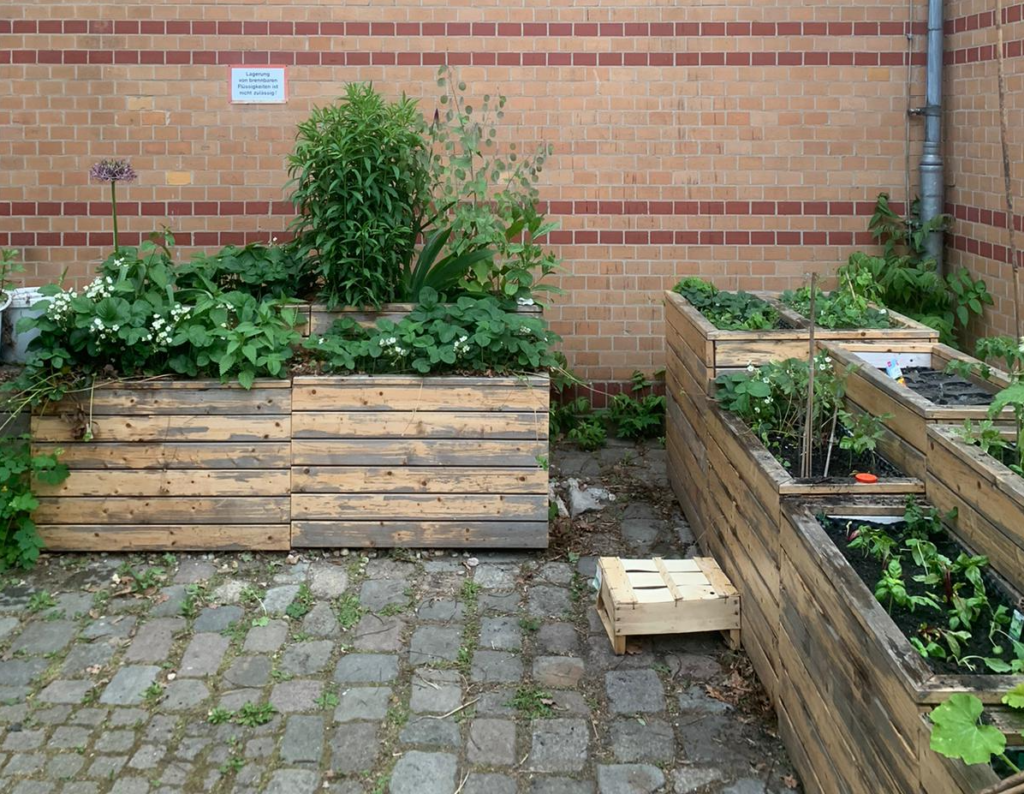
After a successful season start the tandem / groups have continued to look after their raised beds. Ayami, Katharina, Meltem, for instance, were assigned three raised beds. Two of them were already full of left-behind plants, mostly strawberries. With no space to relocate the strawberries, they decided to keep them (instead of throwing them away). This definitely paid off: a week later they could not only find the plant flowering but also noticed some baby berries as well.

In their third raised bed, weeds had made themselves at home. The group took them out and planted two TUmatoes. Luckily, the tomatoes also survived the storm, with the support of a few poles. However, now the tomatoes are struggling with black bugs – possibly vermin?

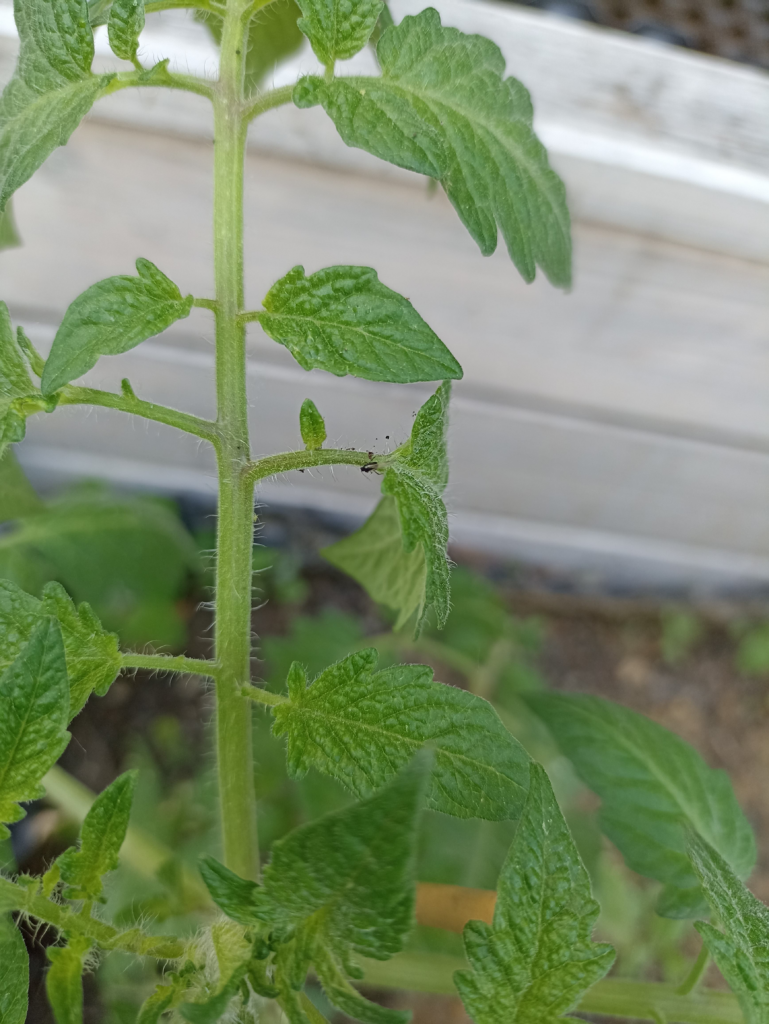
Additionally, they seeded wild rocket next to the tomatoes. With many shoots sprouting only a couple of days later it was hard to know, what are weeds and what are wild rockets.
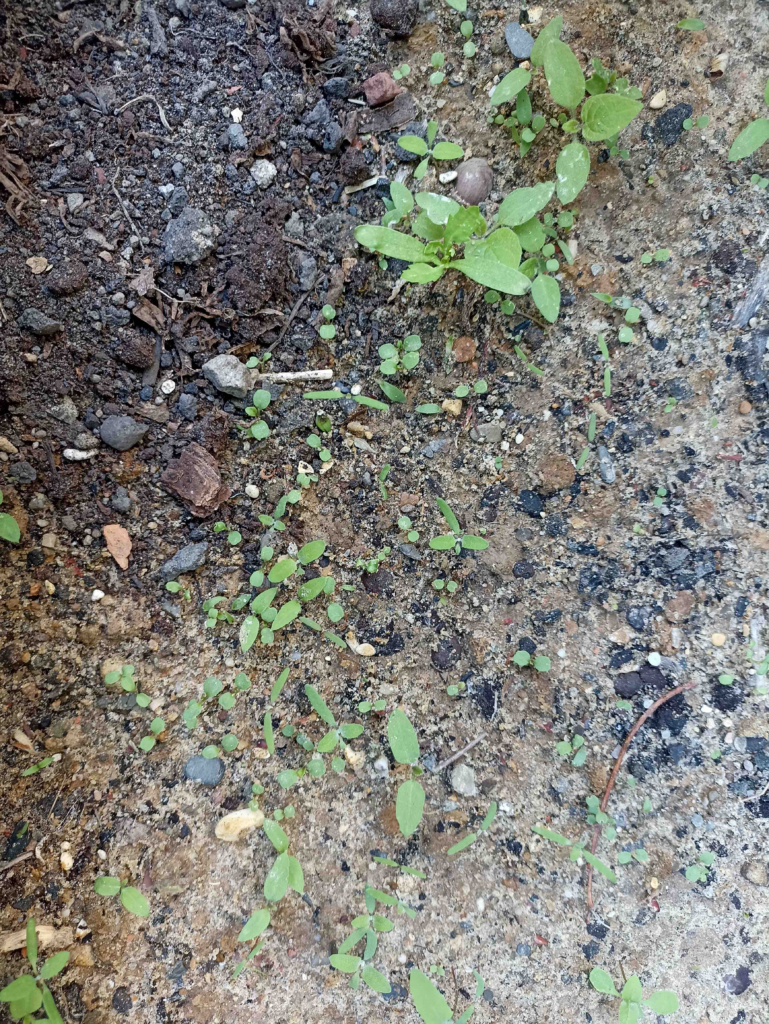
Besides, Fiona, Iqra and Anna added a young zucchini plant to their bed.
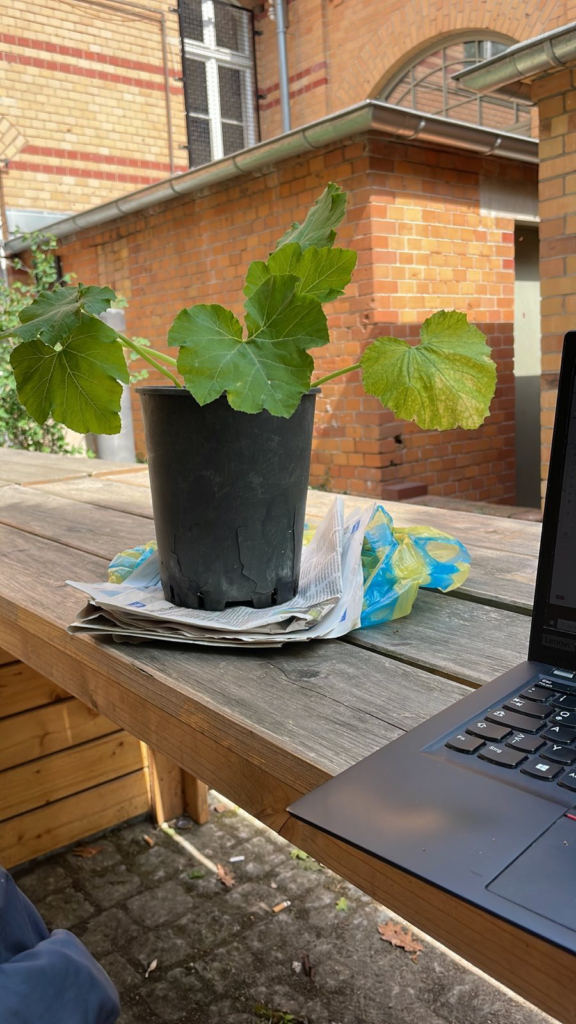
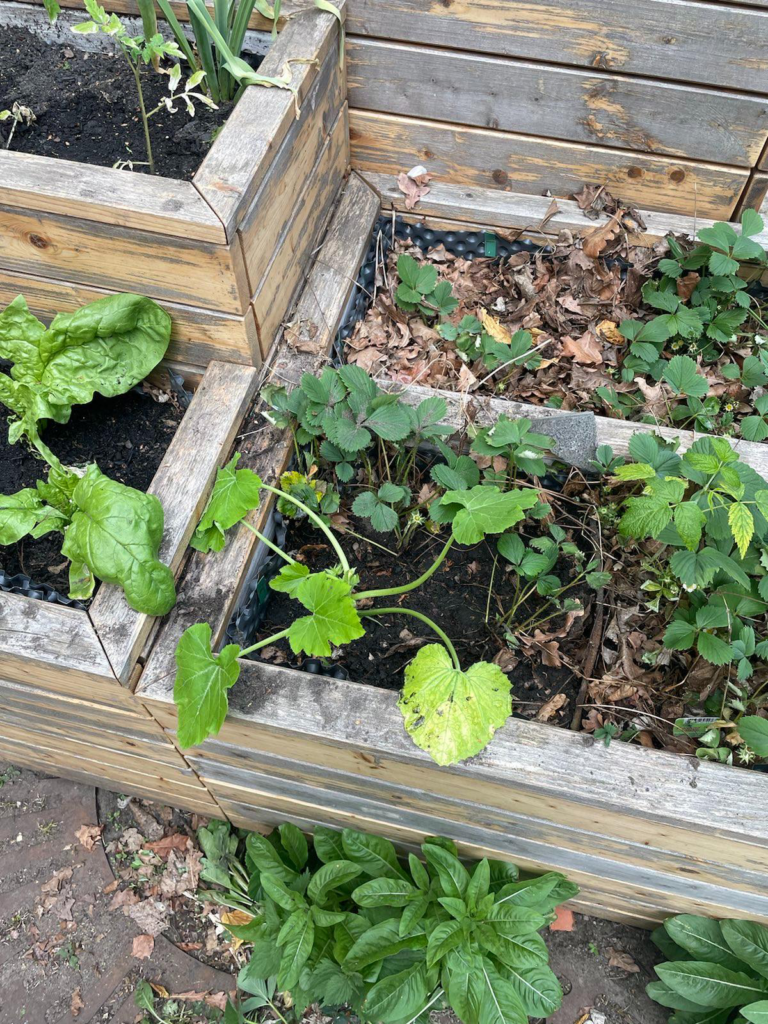
Another tandem, Cornelius and Luisa, planted tomatoes, beans, basil and marigold in the upper bed, and beetroot and kohlrabi in the lower bed.
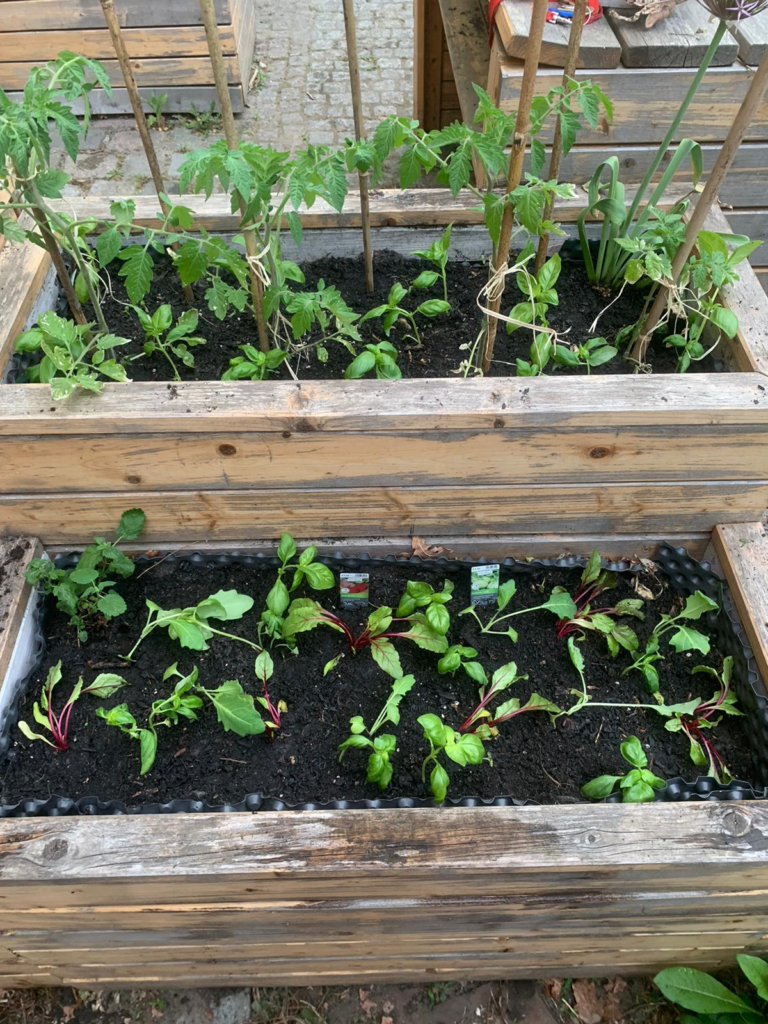
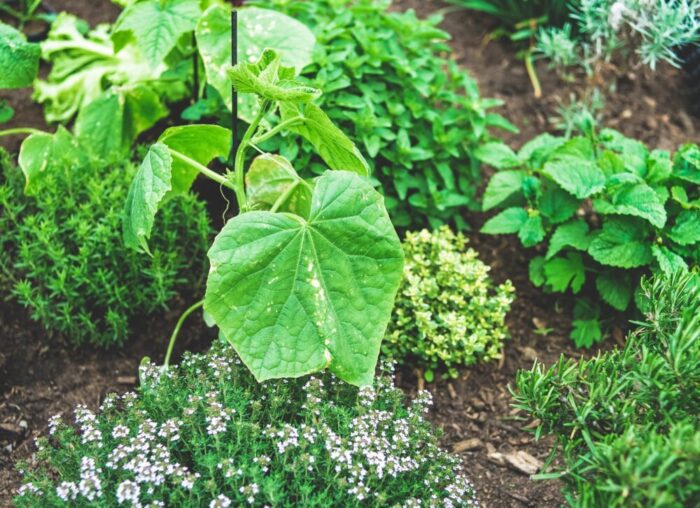
After having obtained a raised garden bed new questions may pop up in your mind like for example: Which plants are the most suited ones? Which plants can be combined? How can the output be maximized? This blog article will give advice and provide some basic information.
Monoculture vs. companion planting
That’s the first question you should ask yourself.
As the name already tells a monoculture is limited to one sort of plant. That makes life easy regarding water and nutrients. And if you favour e.g. tomatos, strawberries or peppers its nice to just cultivate this special plant. A great disadvantage is that if there is any problem like a disease, snails, aphids, fungi etc. it can happen that all the plants are ruined and that no harvest is possible. If you prefer different plants or want to gain experience then choose companion planting. Different plants are combined in one raised bed. You have to be more careful about planting distances and good and bad neighbours but it’s worth trying. It’s a natural form of crop protection (compared to the application of chemicals). The following passages will help you.
Good and bad neighbours
Yes, plants can get in trouble with each other or be best friends. An example: Legumes live in a symbiosis with nitrogen-fixing bacteria. Cabbage plants emit a phytochemical (some kind of mustard oil) over their roots. So when these plants are combined in one bed the phytochemical harms the nitrogen-fixing bacteria.
The table shows good (+), bad (-) and neutral ( ) neighbours. Combine good neighbours of any kind but avoid bad neighbourhood.
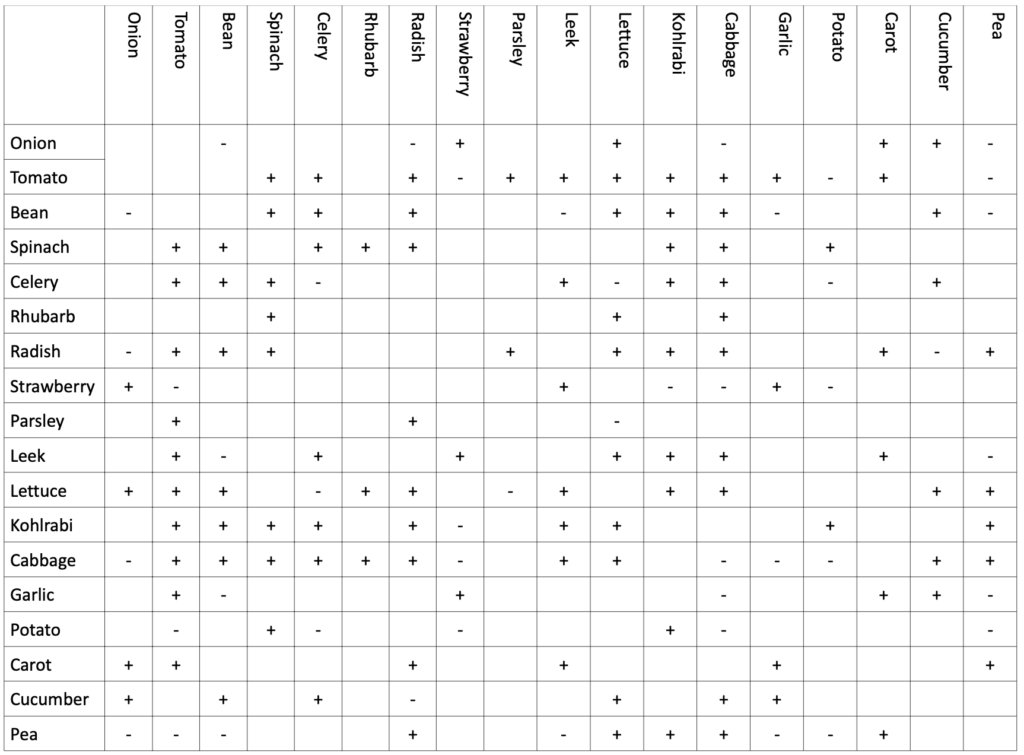
Different plant habits
Combine low plants with high ones and small plants with big ones.
Most beans grow up to the sky and stay small. Celery needs a lot of space for its big tuber, beans don’t. The spinach leaves need a lot of horizontal space. But if they are cultivated as baby leaves spinach is a great fill-in. So, the space of the raised bed is optimally used if the three are combined: Beans stay small and grow up, celery needs space for its tuber but stays compact and spinach can be used as a fill-in or is alternated with celery.
Background, foreground planting
Be careful that plants don’t shadow each other. This depends on the cardinal directions. High plants are put in the north/background of a bed whereas low plants are put in the south/foreground. This guarantees enough sun for everyone.
Plant the beans in the background so that they don’t shadow celery and spinach. Celery and spinach can be alternated or second row celery and third row spinach.
Fast growing plants in combination with long-term cultivation
Combining fast and slow growing plants maximizes the output of a small bed.
In our example celery needs 5 months until it can be harvested, beans need 10 weeks and spinach 6 – 8 weeks. Spinach can be regarded as fast growing especially if it’s cultivated as baby leaves. Celery is slow growing. Look again at the table above. You will see that beans are also friends with radish which is also fast growing. And it’s friends with lettuce. Lettuce is not fast growing but can be cultivated as baby leaves and then it’s fast growing.
That gives an idea how to combine the TUmatos
Add some spinach, lettuce (baby leaves) and radish for a fast first harvest. And maybe some basil which shadows the soil and – by the way – is delicious in combination with tomatos. But please, don’t combine them with potatos. That’s the worst thing you can do as potatos get Phytophthora infestans which also infects tomatos.
Bee food
Here some ideas for people who want to feed bees:
The flowers of beans and peas are a food source for bees. You can also plant broccoli and let it flourish (but then you can’t harvest it). Jerusalem artichoke (German: Topinambur) is also a possibility. It looks like a sunflower and the roots are eatable. Or just plant sunflowers, rosemary, sage, oregano, majoram.
In some shops you can find seeds called „Bienenweide“ or „Bienenbüffet“. These plants and flowers don’t need much water and they prefer soils poor in nutrients.
Last but not least: Have fun! Trial and error is the best way to gain experiences. And for all the people who are overwhelmed by so much information: Don’t worry. Take it easy and do a monoculture or just take two different plants. That’s enough for the beginning. 😉
Written by Katharina Joachimsmeyer
References:
Photo by Markus Spiske on Unsplash
https://www.mein-schoener-garten.de/gartenpraxis/nutzgaerten/mischkultur-erdbeeren-52273 SGD Fernlehrgang „Gartengestaltung“, Heft GAR12 Nutzgarten
https://www.plantura.garden/gemuese/tomaten/mischkultur-bei-tomaten
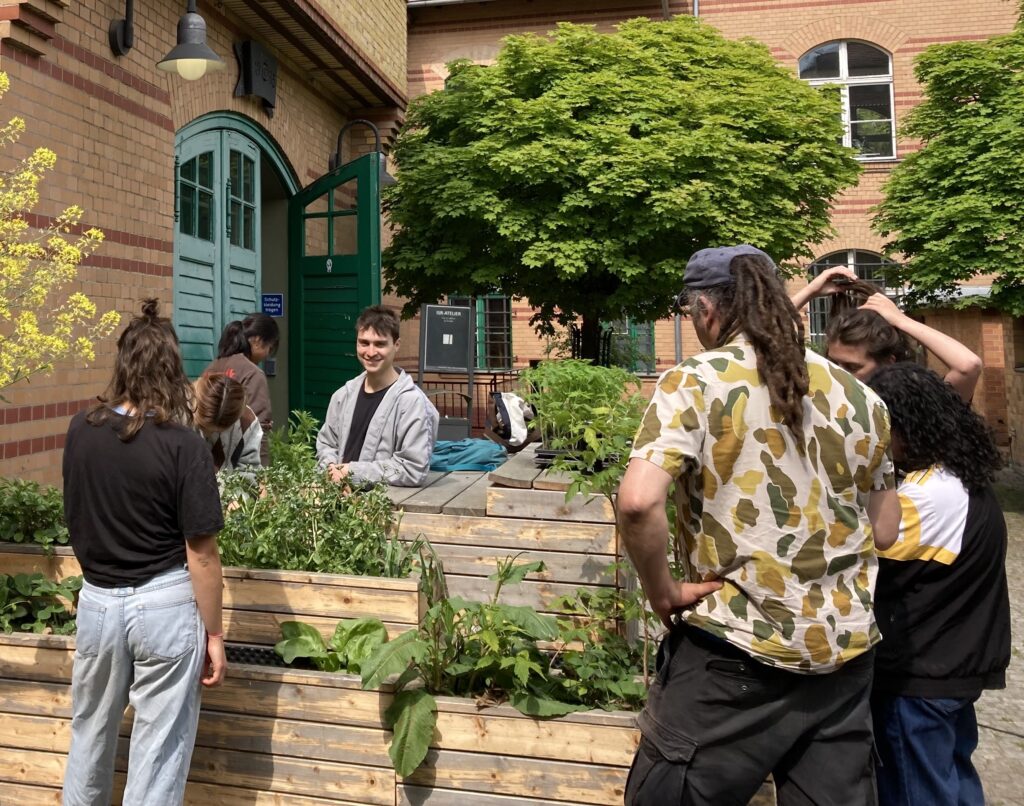
Almost simultanously, in the 1980s, German author Erich Fromm and US-American biologist E.O. Wilson developed the „biophilia hypothesis“. They both believed that humans have an innate inclination to connect with nature and living beings – on which they depend. Biophilia is suggested to be anchored in our genes, an intrinsic relatedness to nature that co-evolved in our cultural setting. Robert Pyle, a believer in the biophilia hypothesis, recalls children’s reactions when he puts butterflies on their noses while teaching about these animals. He often sees an epiphany in the children’s eyes due to the close contact with nature. However, Pyle adds: “This can happen to grown-ups, too“ (1993, p. 136). Yesterday, observers might have witnessed just that: people being bipohilic and experiencing the joy of connecting to other-than-human species, in this case plants.

On a semi-sunny Wednesday afternoon, the seminar group met at TU Berlin – not to pick apples – but to allocate raised beds to the tandem partners. After some introductory words by Janina and Thomas (the DIY spirit was repeatedly praised) the tandem partners quickly started getting their hands dirty. Beds were inspected, inventoried and cropping plans were discussed. Some students started hand-weeding, as the beds had been unattended to for the past two years or so.
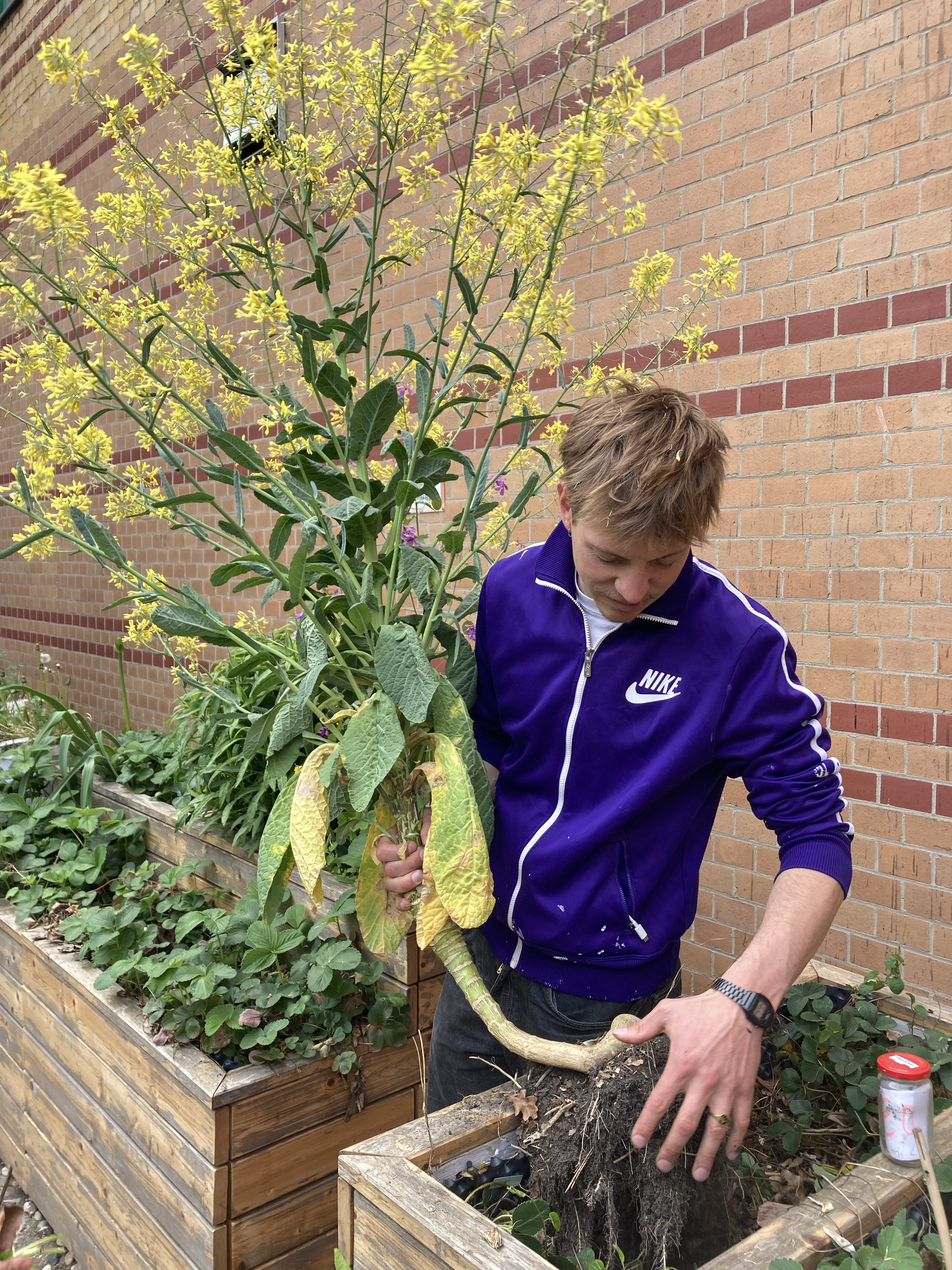
Moreover, every gardening team received a young TUmate, a tomato strain bred by the Chair of Vegetation Technique and Planting Design at TU Berlin using an open source seed license. Some took their plant home, others planted it into the newly obtained raised beds.

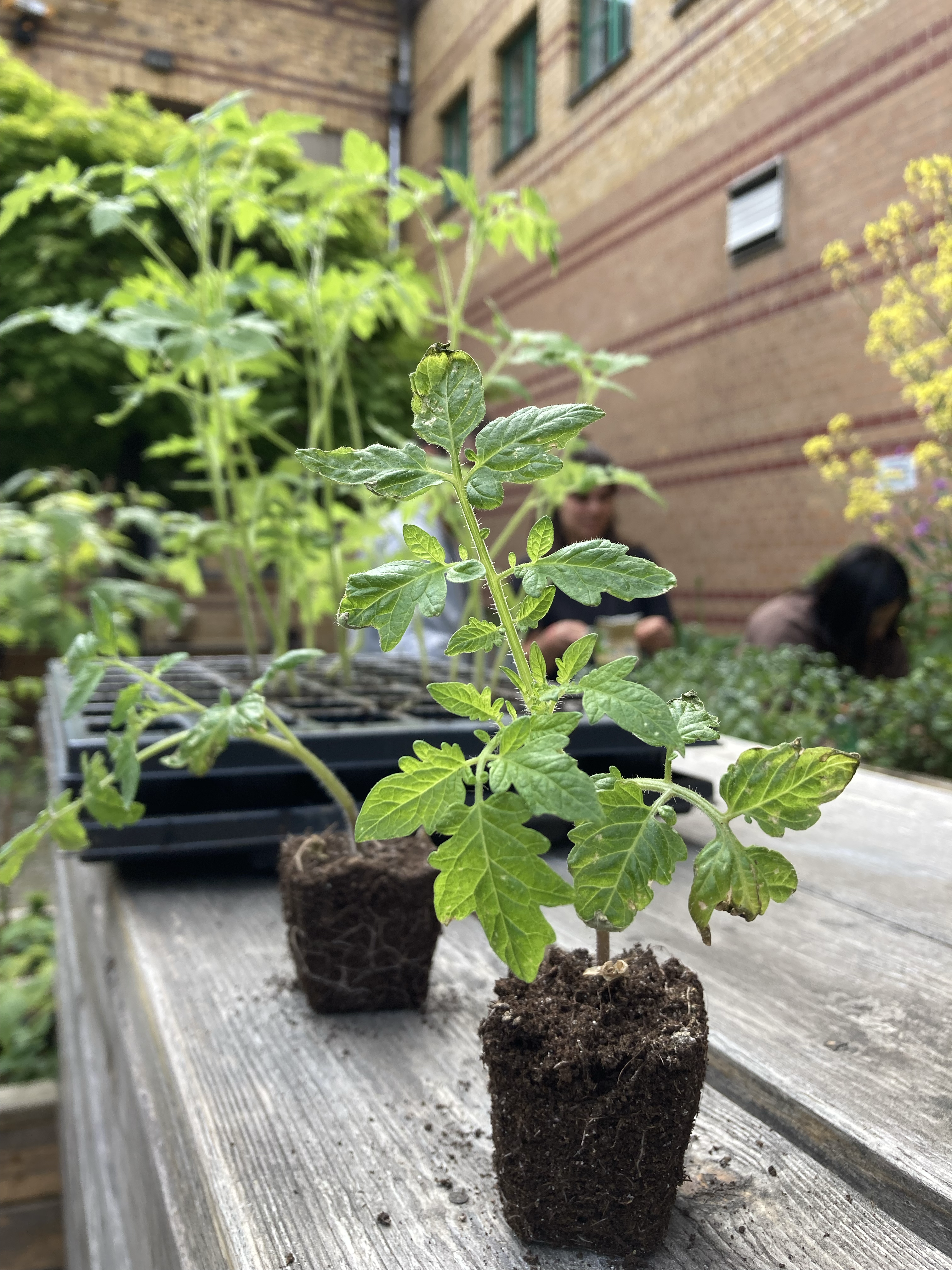
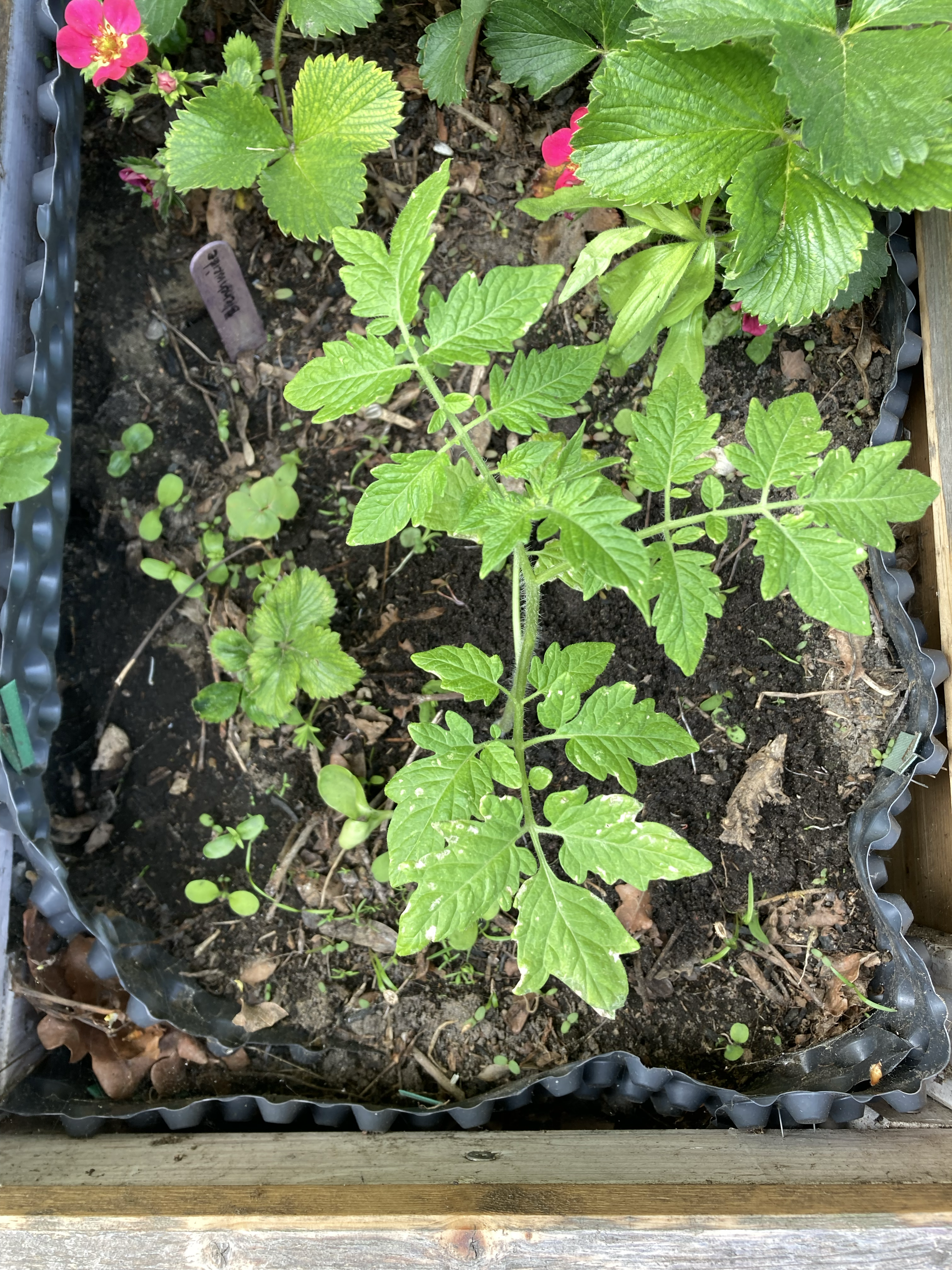
Sources:
Fromm, E. (1981). Die Seele des Menschen (Vol. 35076). Ullstein.
Wilson, E. O. (1984). Biophilia. In Biophilia. Harvard University Press.
Pyle, R. M. (1993). The thunder tree: Lessons from an urban wildland (Vol. 220). Houghton Mifflin Boston.


